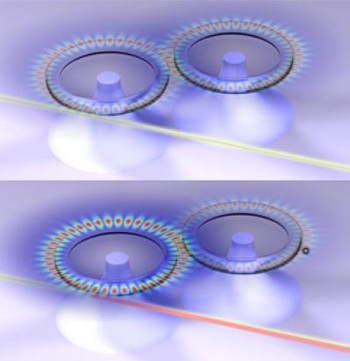
(Top) Two whispering gallery mode (WGM) silica resonators (top), arranged in coupled system with symmetrically distributed supermodes. Pump laser (yellow line) provides optical gain below lasing threshold. (Bottom) Loss is introduced into the second resonator using nanoprobe (black circle), causing mode distribution to become asymmetrical and ultimately triggering Raman lasing in the first resonator. [Image by J. Zhu, B. Peng, S.K. Ozdemir, L. Yang]
Optical systems in the real world must constantly battle against energy loss. In lasers, typically the battle involves pumping external energy from a photon source into the system until the energy gain can overcome loss and lasing can begin. In a strikingly counterintuitive result, an international team of scientists has now devised a new coupled optical system design in which the onset of lasing depends on increasing the overall loss in the system (Science, doi: 10.1126/science.1258004).
To pull off this feat, the researchers started with a pair of coupled whispering gallery mode (WGM) silica microresonators, set up to operate as a Raman microlaser, with an external photon pump providing a conventional gain source. Changing the distance between the microresonators allowed the team to adjust the strength of the coupling and to tune the resonance modes of the coupled system into overlapping “supermodes.” Then, using a chromium-coated, optically absorptive nanotip probe, the researchers gradually introduced loss into the system by leaking optical pump energy away from one of the two coupled microresonators.
Initially, adding loss to the system using the nanotip suppressed lasing, as one might expect in a conventional laser. But once the amount of loss in one microresonator had reached a critical threshold, the other resonator kicked into action, and “loss-induced” Raman lasing began.
The key to this apparent magic lies in the detailed math of the coupled system. For ideal physical systems in which conservation of energy applies, the total system energy state, or Hamiltonian, can be described mathematically by a so-called Hermitian matrix—one whose eigenvalues consist only of real numbers. But for many open, lossy physical systems, such as lasers, the Hamiltonian matrices are actually non-Hermitian, with complex eigenvalues. And at certain singularity points in the parameter space of such systems (known as “exceptional points,” or EPs), multiple complex eigenvalues can coalesce.
Nudging the system toward these EPs, as the team did with the coupled WGM microresonator system, turns out to open the door to some very interesting physics—such as loss-induced lasing. “This turns the conventional textbook understanding of lasers upside down,” according to Sahin Kaya Ozdemir, one of two lead authors on the paper. Moreover, while these experiments used coupled WGM microresonators and Raman lasing as the platform of choice, the underlying principles, which the scientists say can apply to any coupled physical system, could spawn new schemes for controlling the effects of loss in photonic crystals, plasmonics and other contexts.

